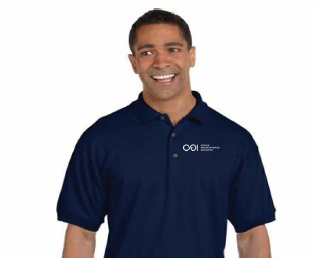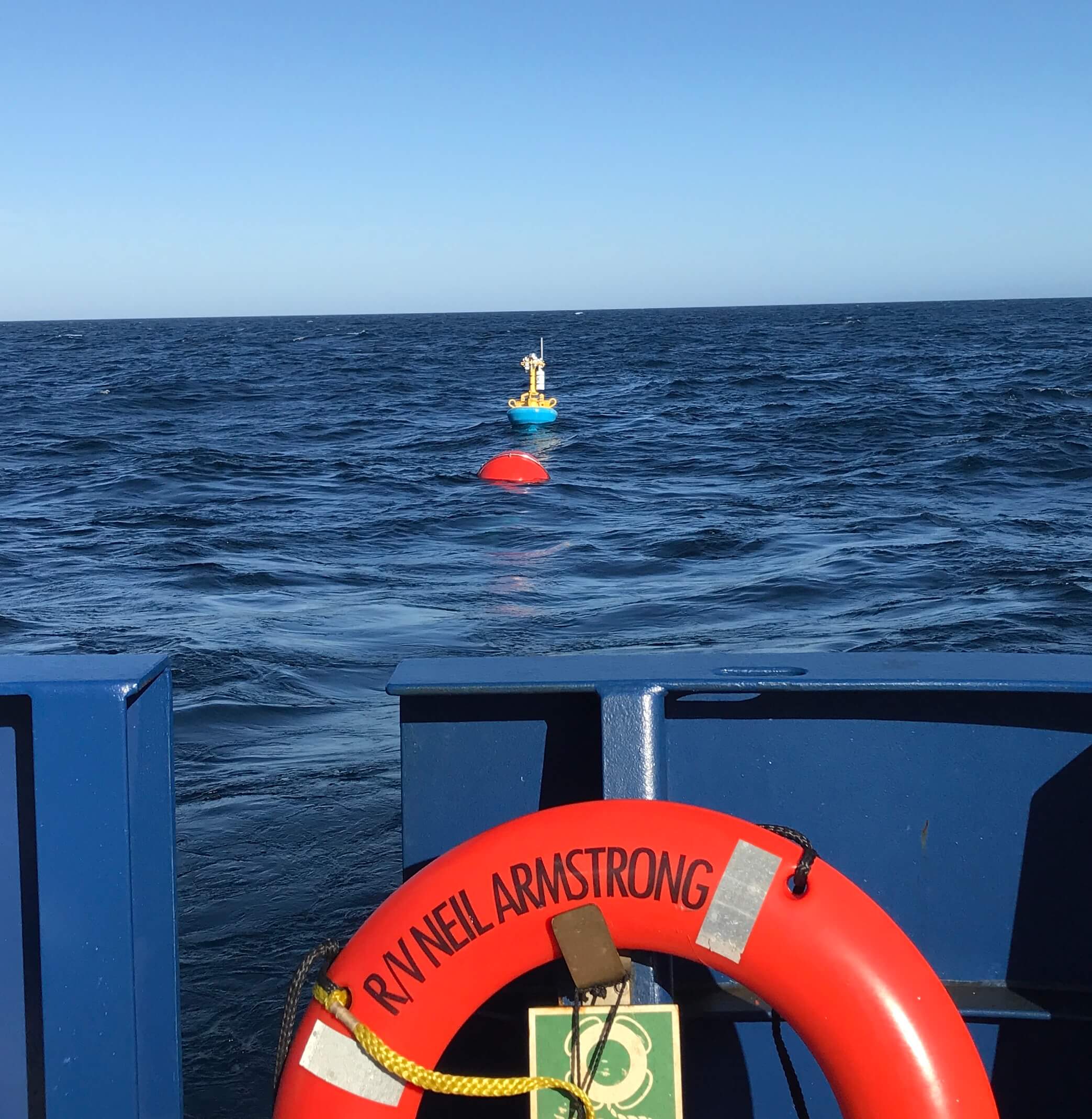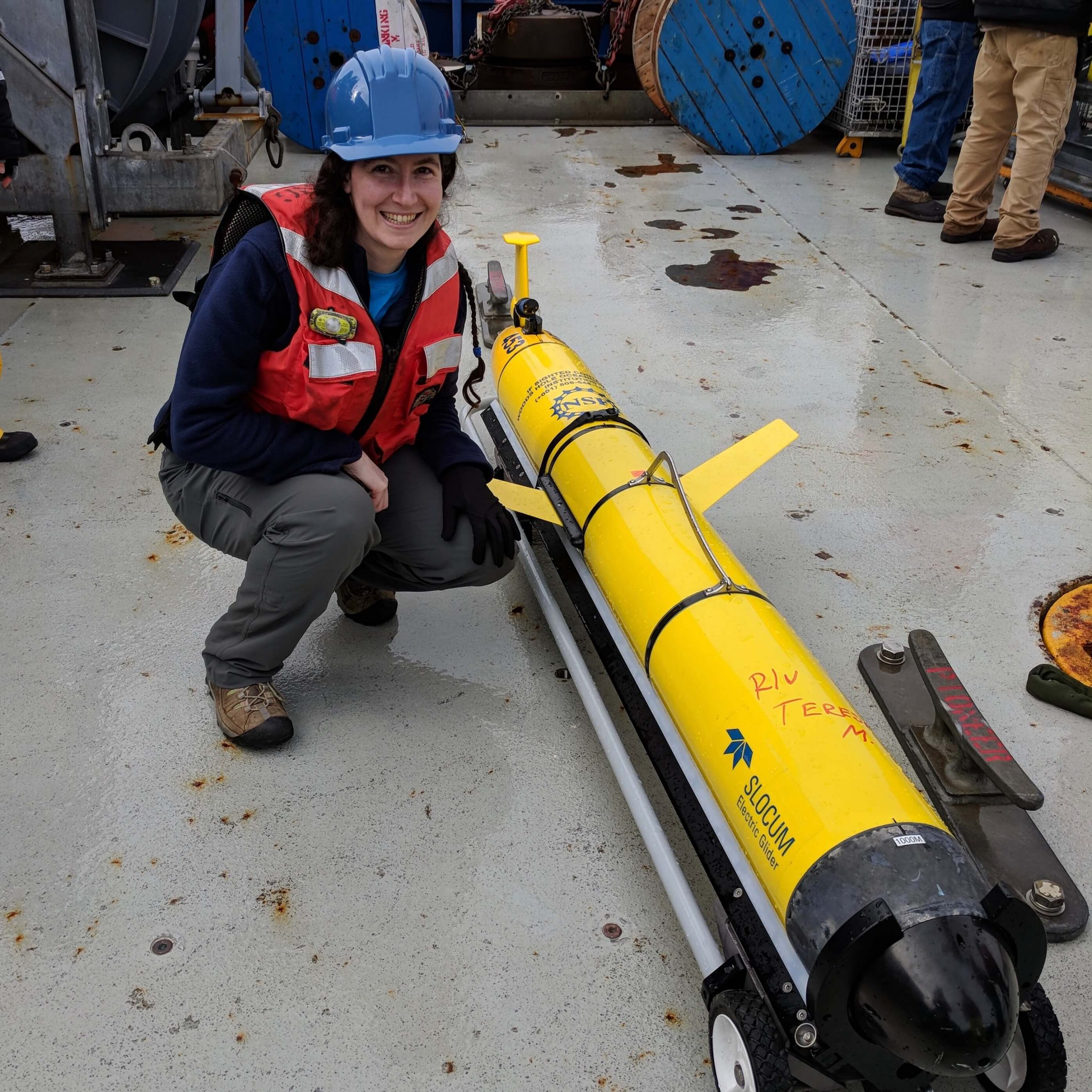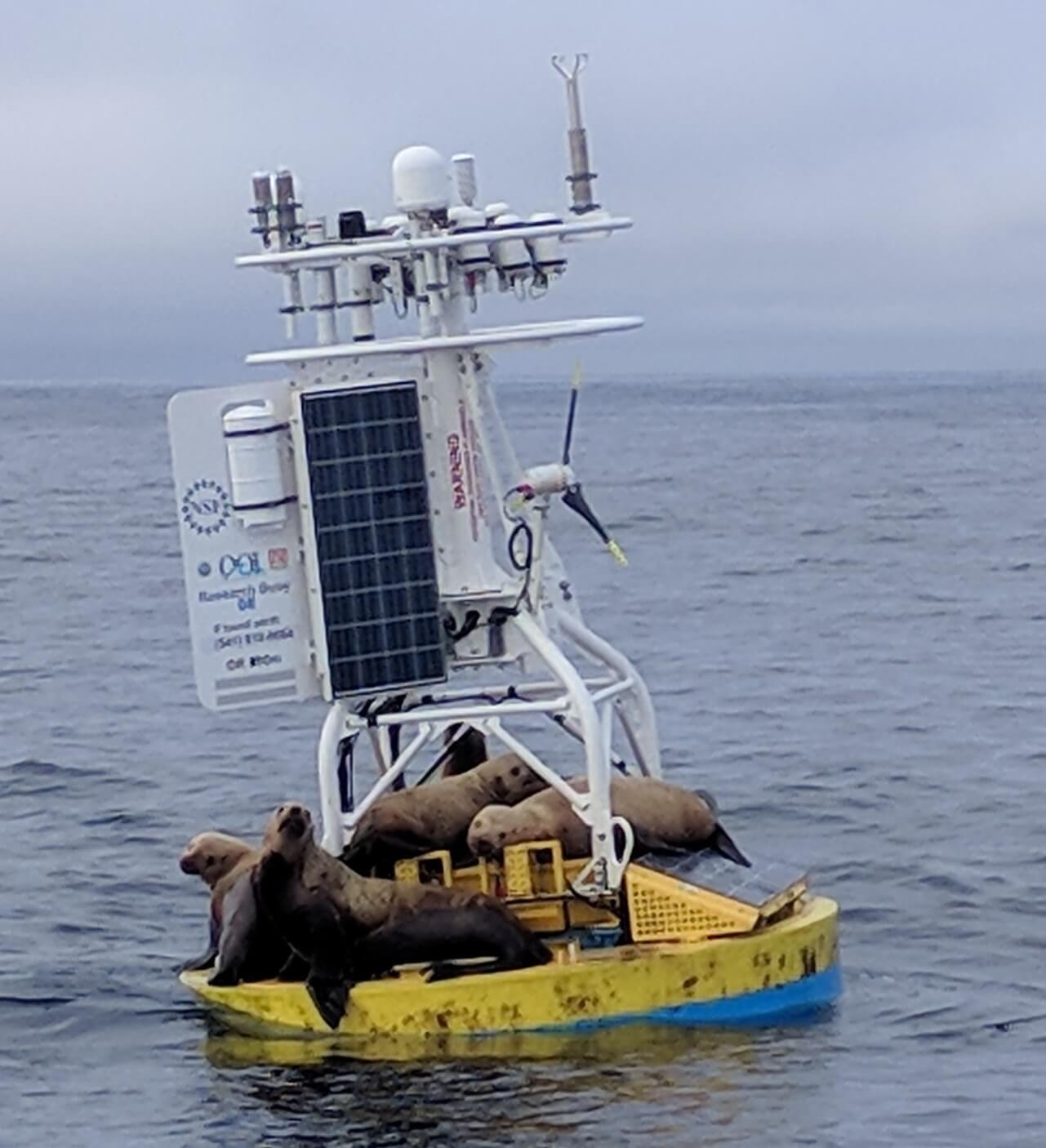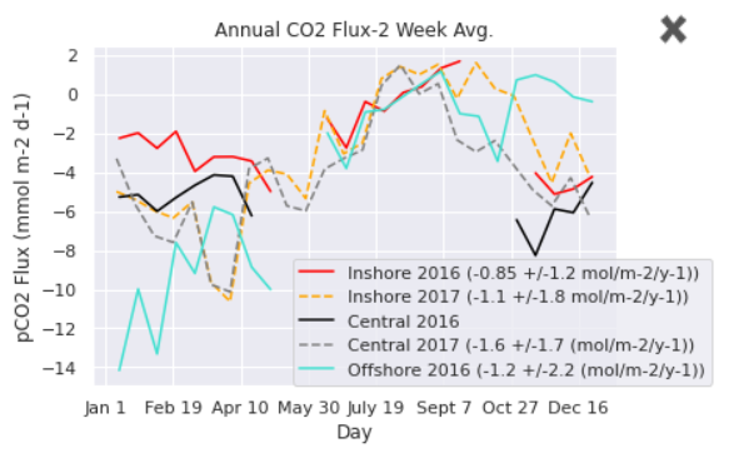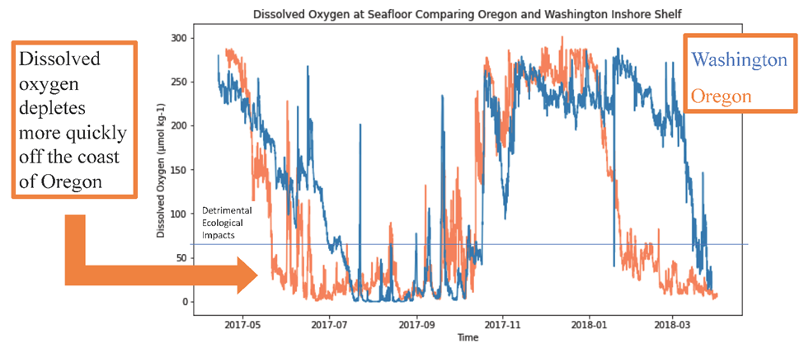Posts by ooistaff
OOI Branded Apparel Available to Order
Interested in showing your affiliation with OOI? Now you have an option for purchasing a wide array of OOI Branded merchandise. From tee-shirts to polos to dress-for-success Zoom shirts, we have it all!
Woods Hole Oceanographic Institution’s Gift Shop has graciously offered to help provide OOI apparel to all those who might want to purchase it. You can view the array of products here: OOI Branded Apparel.
Download and complete an order form so we can get your new merchandise on its way. If you are interested in ordering something, please place your order by March 31st.
If you have any questions, please reach out to Darlene Trew Crist.
Read More
Potential Pioneer Relocation Innovations Lab on March 15-19
In 2021, the Ocean Observatories Initiative Facilities Board (OOIFB) and the National Science Foundation (NSF) launched a process to consider whether to move the Pioneer Array from its current location, on the New England shelf and slope south of Martha’s Vineyard, to a new site. Selection of the next OOI Pioneer Array location, or decision to maintain the Array at its current location, will be driven by community input on the important science questions that can be addressed by the Pioneer Array.
The OOI community has been invited to weigh in on this important decision during a two-phase sequential lab approach that is bringing together scientists, educators, and other stakeholders together virtually to evaluate 1) future location options for the Pioneer Array and 2) new design considerations that can enable exciting research endeavors at the chosen location.
The Phase 1 Innovations Lab will be held on March 15-19 to explore possible locations for the Pioneer Array based on multiple factors, driven by scientific questions that require an ocean observatory to advance knowledge. At the Lab, interdisciplinary teams will work together to ideate and develop a roadmap of possible locations including exploring new scientific, educational, and partnership opportunities. Participation was open to the all, and 32 applicants were selected to participate in this important decision.
The Phase 2 Innovations Lab, in late spring/early summer, will come up with a plan to maximize the science gains and broader impacts of the potential new site. If a new site is recommended, the Array would be moved in 2023. The OOI Coastal and Global Scale Nodes (CGSN) Team at Woods Hole Oceanographic Institution would continue the operation and maintenance of the array, regardless of its location.
The Lab’s findings will be considered by an NSF review panel, which will report to NSF in early fall on the new Pioneer Array location and how it can be optimized for science and education. The findings of both Innovations Lab will be shared with the OOI community.
Read MoreHilary Palevsky: From landlocked to ocean expert, teacher, mentor
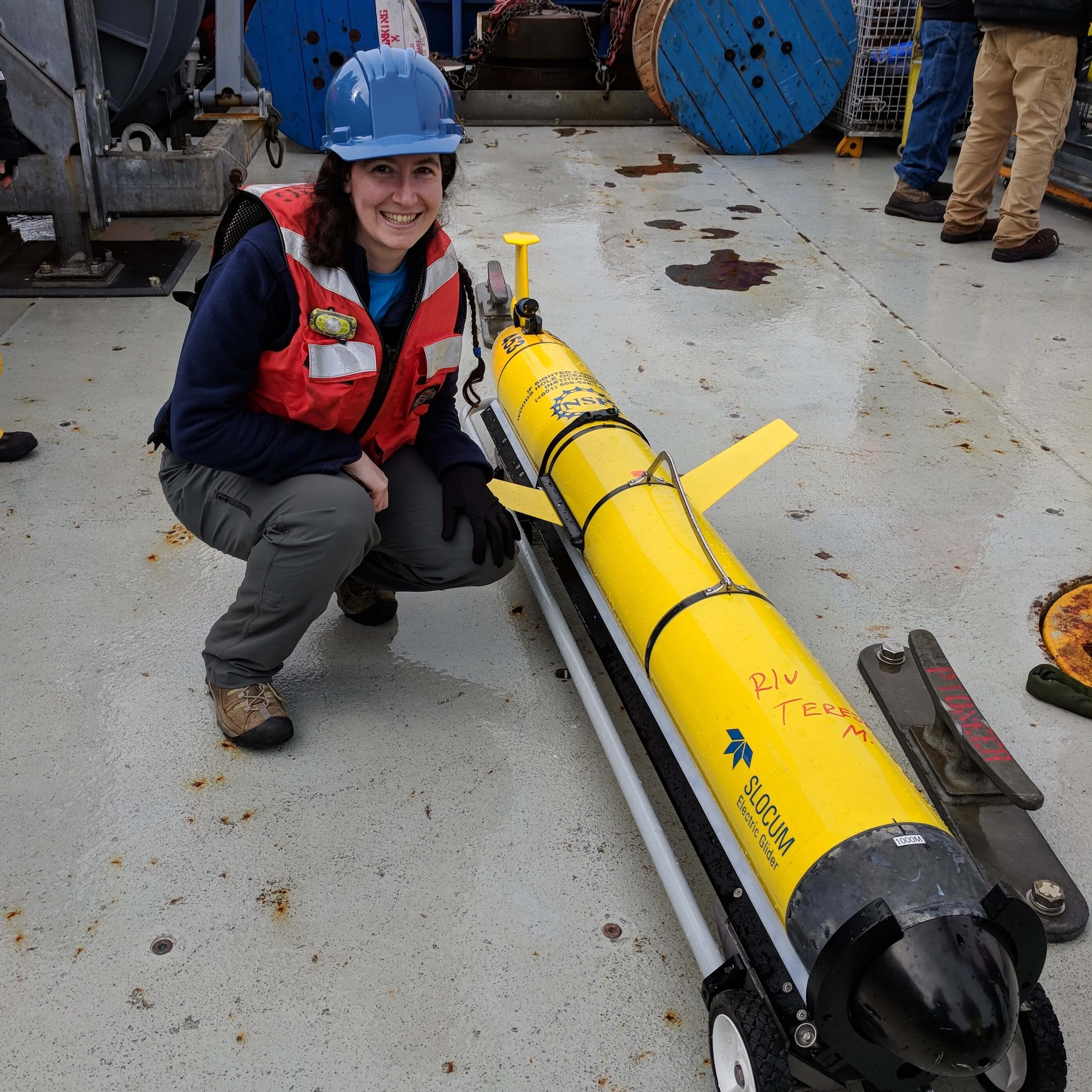 Hilary Palevsky, Assistant Professor, Boston College[/caption]
Hilary Palevsky, Assistant Professor, Boston College[/caption]
Having grown up landlocked in Western Pennsylvania, Hilary Palevsky had never thought much about the ocean nor ever imagined studying oceanography. That all changed in her junior year of college when she participated in the Williams-Mystic Maritime Study Program. At the very beginning of the semester, she went to sea for 10 days aboard the Sea Education Association’s SSV Corwith Cramer. This experience turned out to be the perfect confluence of events for her future career path.
“I just fell in love with everything about the ocean – not only the science of it, but sea shanties, and maritime history and literature, “ explains Hilary. “I really wanted to do something about climate change. Realizing that the ocean plays this totally dominant role in the Earth’s climate system on human-relevant time scales, I knew that’s what I wanted to do.”
After graduating from Amherst College, she wasn’t sure what direction she would pursue but whatever it was, it would be ocean-related. Hilary took on a fellowship to study interactions between policy, science, and stakeholders through the lens of North Atlantic cod fisheries. She traveled all over the north Atlantic coast talking her way on to fisheries research vessels and small fishing boats. (As a 20-year-old woman, the former was easier than the latter). She also gave K-12 marine science education on traditionally-rigged schooners a try before she stepped on the path to getting a PhD in oceanography and a graduate certificate in climate science at the University of Washington.
Hilary is now an assistant professor at Boston College. Her research focuses on how the ocean takes up carbon dioxide from the atmosphere and the chemical, physical, and biological processes involved. A through line for her research are places that have strong seasonal cycles, which is how she came to work with OOI data. She was interested in getting measurements of how much carbon the ocean was taking up throughout the seasonal cycle in the subpolar North Atlantic. “There is a really interesting and exciting interplay between biological processes – a huge spring bloom in the North Atlantic—and physical processes, where there’s really deep winter mixing.” To understand how these two interact requires having measurements throughout the year. OOI makes this possible by continuously collecting this data, including times when it’s too cold and stormy to be out there on a boat.
Mentoring makes a difference
A major part of Hilary’s professional life now revolves around teaching. She is one of those exceptional teachers who makes science accessible and interesting. Hilary is also one heck of a mentor.
“My understanding of mentorship and role modeling have changed over time. I didn’t feel like the gender identity of my mentors mattered to me [as an undergraduate] because I had awesome women mentors. I had a great undergraduate senior research advisor, for example, who modeled other things [than just research] for me. She was married to another woman, I met and got to know her wife. From her, I learned how to figure out how to be a person doing science rather than a scientist trying to be a person.” Hilary actually met her spouse for the first time in her advisor’s office!
Having such mentoring and role model representation early on in her career were particularly important to Hilary as a woman and a queer person. She didn’t experience the barriers that often exist because she had role models who demonstrated how she could survive and thrive in the scientific academic community.
“It was only later on in my career, when all of my advisors were straight men, that I recognized that there was really something important about my early mentors. But today I also recognize that all of my mentors have provided important things along the way. I have had male mentors who have been great role models for me as a woman. I’ve had straight mentors who have supported me as a queer woman with a spouse who is transgender.”
Hilary’s experiences have made her adamant about the importance of being a good mentor, particularly for people who don’t share the same identities. “I think about myself as a white woman who now mentors undergraduate and graduate students in a field that is overwhelmingly white. I constantly ask myself what do I have to do to be an effective mentor to students of color and coming from backgrounds and identities that are different from mine?”
Until a truly inclusive and diverse science community exists, Hilary believes it is imperative that leaders in academia find ways to be effective mentors for people who don’t either look like them or share some or all of their identities. “While the Geosciences has made some progress in gender parity, the representation of people of color has not made the same gains. The fact that I as a white woman have a faculty position shows there’s been progress, but we have to start making this happen for Black women, Indigenous women, trans women, all of whom haven’t been making these same gains as white women.”
Profiles of Other Exceptional OOI Women
[caption id="attachment_20422" align="alignnone" width="300"]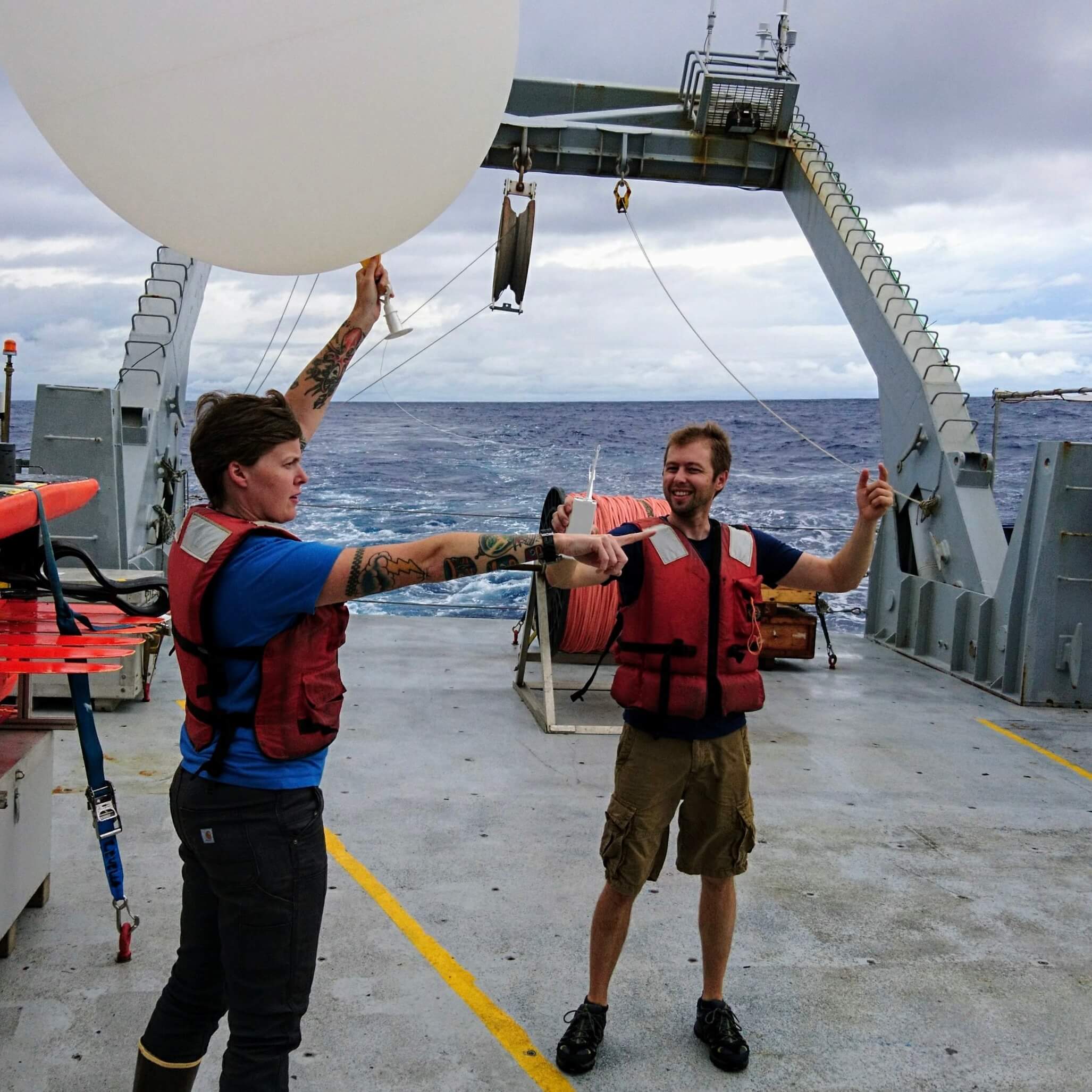 Sophie Clayton, Assistant Professor, Old Dominion University[/caption]
[caption id="attachment_20424" align="alignleft" width="300"]
Sophie Clayton, Assistant Professor, Old Dominion University[/caption]
[caption id="attachment_20424" align="alignleft" width="300"]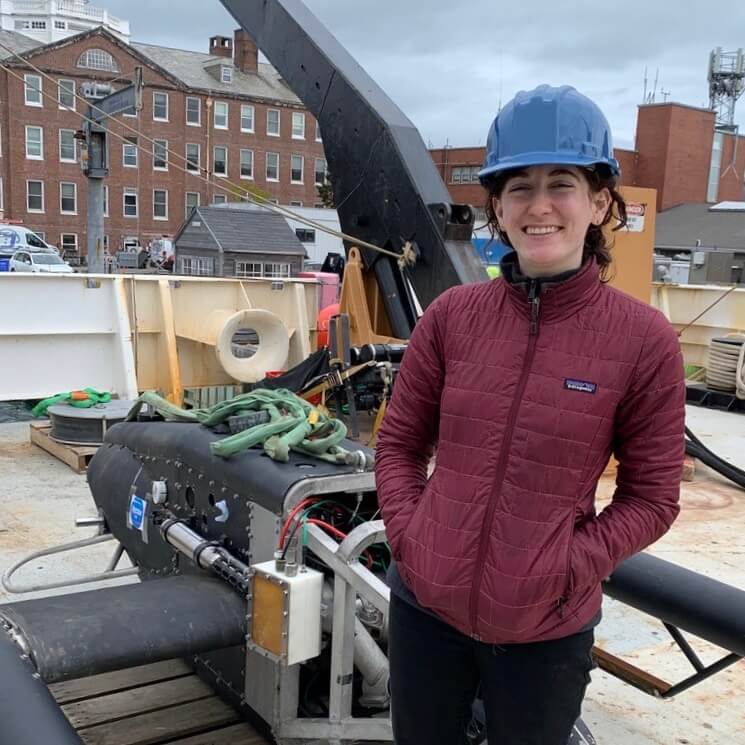 Hilde Oliver, Postdoctoral Scholar, Woods Hole Oceanographic Institution[/caption]
Hilde Oliver, Postdoctoral Scholar, Woods Hole Oceanographic Institution[/caption]
Read More
Sophie Clayton: Curious, Creative, with an Irrepressible Desire to Understand Connections
 Sophie Clayton, Assistant Professor, Old Dominion University[/caption]
Sophie Clayton, Assistant Professor, Old Dominion University[/caption]
Sophie Clayton learned how to swim before she could walk. She spent her early years with her family exploring beaches during summer vacations in the south of France. Her fascination with being in and around the water never waned. Her dad finally relented and bought Sophie her first pair of diving fins when she was seven, even though he thought her curiosity might sweep her away!
Early on, Sophie excelled in math and science, but a move to Scotland at age 16 started her on a new track. Her first stint at higher education landed her in art school, where she majored in fine art, photography her primary medium. After graduating, uncertain of her next steps, she took a gap year in Australia. There, too, the water called her name.
A SCUBA diving course north of Sydney, put her on track to become a divemaster and then a diving instructor. She went on to teach diving on the Great Barrier Reef and in the Maldives, spending seven days a week in the water for the better part of three years.
One day it dawned on Sophie that she needed to better understand the environment in which she had surrounded herself. She decided to become an oceanographer. She headed back to the UK, north west Wales in fact, offering quite a different environment than the tropics, where she earned a degree in oceanography.
From there, the path was rapid and clear—mostly. In 2006 she landed a Research Experience for Undergraduates (REU) spot at Woods Hole Oceanographic Institution (WHOI) advised by physical oceanographer Prof. Annelisa Bracco. She was admitted to the WHOI/MIT Joint Program in oceanography the following year and earned her PhD in Physical Oceanography. After a postdoctoral stint at the University of Washington, Sophie returned to the East coast to join the Ocean and Earth Sciences faculty at Old Dominion University as an Assistant Professor
Always an artist
“I seem to have come full circle from my art school days. Now I’m working with imaging instruments, studying phytoplankton. I get a lot of people asking me: aren’t art and science really different and don’t you feel like art school was a waste? My answer is always ‘Absolutely not!’ I use a lot of my in art school training—independent study and researching around a topic—we were taught to explore ideas and approach them from every angle. I apply the same thought processes to my science now. The difference is the toolkit.”
Sophie excels in making connections, which are not always obvious. While trained in physical oceanography, she studies the interactions between the ocean biology, biogeochemistry, and physics. As a result, she pulls lots of the pieces together in a system to see how they all work in concert. The question she is now exploring is how ocean circulation features, especially fronts and eddies, shape phytoplankton communities. She strives to answer this question by looking at the big picture: the impact of how much light they get, the supply of nutrients, what happens when mixing communities from different places together.
Mentors and Networking
When asked about who helped mentor her along the way, Sophie responded that “lots of people have.” She called out Prof. David Bowers, a physical oceanographer who advised her during her undergraduate studies in the UK, Prof. Annelisa Bracco, her WHOI REU mentor, and Prof. Mick Follows, her graduate advisor at MIT, for their support and guidance at important transitions in her life, but said that many others have helped her on her circuitous path.
“As a grad student, I made a point of going to talk to people about their research and to discuss my work and ideas. I have been really lucky to have built relationships that have come about from these conversations and keeping in touch over the years.” She views her mentors as a combination of senior people, both men and women, who have helped her in her career, and her peers, who have provided practical advice on advancing her science, teaching, and life. “Senior women in particular have shown me what’s possible and served as examples of how it is done.”
When asked for counsel for other women considering careers in science, Sophie suggests taking the time to find the right graduate and post doc advisors. “These folks have a tremendous impact on our lives and our future, so it’s important to take the time to make sure that they are a good fit and you will work well together.” Her other words of advice are “talk to people, chatting about your science is important and you’ll be surprised at not only what you learn but the connections you will make.”
Profiles of Other Exceptional OOI Women
[caption id="attachment_20424" align="alignnone" width="300"] Hilde Oliver, Postdoctoral Scholar, Woods Hole Oceanographic Institution[/caption]
[caption id="attachment_20423" align="alignnone" width="300"]
Hilde Oliver, Postdoctoral Scholar, Woods Hole Oceanographic Institution[/caption]
[caption id="attachment_20423" align="alignnone" width="300"] Hilary Palevsky, Assistant Professor, Boston College[/caption]
Hilary Palevsky, Assistant Professor, Boston College[/caption]
Read More
Hilde Oliver: Carrying on the tradition of smart, educated women
 HIlde Oliver, Postdoctoral Scholar, Woods Hole Oceanographic Institution[/caption]
HIlde Oliver, Postdoctoral Scholar, Woods Hole Oceanographic Institution[/caption]
Hilde Oliver, an oceanographer studying biophysical interactions and a Woods Hole Oceanographic Institution (WHOI) Postdoctoral Scholar, comes from a long line of educated women. Both her grandmother and her mother have PhDs in science, so Hilde is a third-generation woman in science.
“I come from an environment where women were strongly encouraged to pursue science. Not only did my grandmother and mother serve as role models growing up, but they were also always fully supportive of me doing this type of work,” said Hilde.
Midway through her pursuit of her PhD in marine sciences, Hilde was surprised to learn that her grandmother had initially been interested in studying oceanography herself but ended up studying biology. “It was a time when women weren’t encouraged to do that type of work and weren’t really wanted in ship environments. It was interesting to learn that we had similar interests.”
Hilde also attributes her predilection toward the sciences due to living in the small city of Oak Ridge, TN, home of Oak Ridge National Laboratory and a community oriented toward math and science. Growing up there instilled in her a “love for all things math and science.” Her interests ran the gamut from biology, chemistry, physics, and math.
During her freshman year, settling in as a math major at the University of South Carolina, Hilde took an Honors Ecology and Evolution class. During this class, she learned how to apply simple differential equations to fundamental predator-prey interactions—knowledge that launched her trajectory as an ocean ecosystem modeler. Hilde went on to earn her PhD from the University of Georgia and headed north to Woods Hole Oceanographic Institution for a postdoc position with Dennis McGillicuddy and Gordon Zhang.
Studying plankton with models and observations
At WHOI, Hilde is investigating how changing large-scale circulation influences phytoplankton growth in the Mid-Atlantic Bight. She is adding observational work to her modeling efforts using OOI glider data. “I thoroughly enjoy working at WHOI, where OOI is managed and operated. It is so exciting to be working in the environment where people are developing and deploying the instrumentation I’m applying in my research.” OOIs physical and biogeochemical datasets have allowed her to study biophysical interactions near the New England shelfbreak as a part of the larger NSF-funded Shelfbreak Productivity Interdisciplinary Research Operation at the Pioneer Array (SPIROPA) project.
Hilde also recently spent 60 days aboard the global-class research vessel R/V Roger Revelle with a team operating a towed underwater microscope system, the Video Plankton Recorder. The scientific team headed to the Pacific sector of the Southern Ocean to assess the chemical and biological conditioning of Subantarctic Mode Water, which is formed north of the Antarctic Circumpolar Current. The team was in search of coccolithophores, phytoplankton that form calcium carbonate shells.
Due to covid restrictions, the team was forced to depart from Honolulu, traveling all the way from 21° North to 60° South. The length of the transit to the research site nearly doubled their time at sea. This long transit left the team with only 32 days to conduct their research, which they used to full advantage, including finding coccolithophores.
A solid foundation of support
Many have played pivotal roles in Hilde’s path to the sciences. In addition to her family legacy, Hilde’s PhD advisor, Patricia Yager, was hugely instrumental in encouraging Hilde as a woman in science. Yager taught her the ins and outs of being a female scientist in a field once dominated by men while encouraging Hilde to pursue her own ideas.
“Tish (Patricia) instilled in me the confidence to become independent in my thinking,” she explained. “And, for any early-career person developing that independence is critical. So I am very grateful to her for that.”
Hilde offers that two takeaways from her positive relationship with Yager: “It’s important to work with people you want to work with, particularly during your PhD, for you are signing on for five or more years, a long time if it’s not a good fit. Also, it’s vital to develop a working relationship based on mutual respect so that everyone can positively benefit from the time spent together.”
With these tenets in mind, Hilde hopes to one day build a research program of her own that is highly interdisciplinary, takes advantage of the variety of datasets and tools available, and serves to help early-career scientists advance their own research ideas to their fullest expression.
Profiles of Other Exceptional OOI Women
[caption id="attachment_20423" align="alignnone" width="300"] Hilary Palevsky, Assistant Professor, Boston College[/caption]
[caption id="attachment_20422" align="alignnone" width="300"]
Hilary Palevsky, Assistant Professor, Boston College[/caption]
[caption id="attachment_20422" align="alignnone" width="300"] Sophie Clayton, Assistant Professor, Old Dominion University[/caption]
Read More
Sophie Clayton, Assistant Professor, Old Dominion University[/caption]
Read More Shade and Poop at Sea: Increasing Solar Panel Efficiency
Sea lions intermittently visit the Coastal Endurance Array moorings off the coast of Oregon, where they lounge, bask in the sun, and “do their business.” These visits create two problems for the optimum functioning of the instrumented arrays. Because sea lions are heavy, some weighing up to 2,500 pounds, the solar panels upon which they rest need to be strong enough to bear this weight. And, excrement left behind by these itinerant visitors smears and shades the solar panels, making less power available for the ocean observing instrument attached to the arrays.
This intermittent excrement-related shading compounds an existing shading problem caused by the perpetual movement of the moorings. The halos at the top of the moorings cast shadows over the panels below, resulting in a significant power loss. If ten percent of a solar panel is covered in shadow, for example, its output can drop by as much as 70 percent. When sea lions take refuge on the solar panels this loss is exacerbated. Their excrement, at times, can cover up to 30 percent of the panels, virtually wiping out the power generating capability of the panels. Luckily, this coverage results in only a temporary power shortage as wind and seawater ultimately wash away the remains of these visits.
OOI Engineers John Reine and Marshall Swartz of OOI’s Engineering Team put their heads together to tackle these problems. They first addressed the shading issue.
“These moorings are never still,” explained John Reine, Senior Engineer and lead of OOI’s Electrical Refurbishment Team. “In response to wave and wind-driven motion, the masts are always going back and forth, about three times per minute, casting shadows as they move. So this constant movement of shade, no shade, shade, no shade, produces a sort of alternating current from the panels. I went to Marshall and asked how do we fix this?” (John Reine explains the problems and fixes in the video below).
[embed]https://youtu.be/1d6QQJfHqik[/embed]Solar panels are made up of lots of little solar cells, normally connected to each other so the power flows seamlessly from cell to cell. The Engineering Team recognized that by modifying the panel’s internal circuitry, it could easily harvest more of the available light. They proposed a solution to triple the number of bypass diodes, switches that would ignore shaded cells and move the power to the next operational cell in this field of cells. The manufacturer built a prototype based on an high efficiency cell design, inserting additional diodes, and tested the upgraded array. Tests at the manufacturer’s verification facility and at WHOI showed the modified design exceeded expectations.
Timing was opportune. The original solar panels had exceeded their design lifetime and needed to be replaced, but were no longer in production. The team seized on this opportunity to seek out panels incorporating more efficient cells, wired into a circuit proven to minimize shading energy losses, while also bearing the weight of the itinerant visitors.
The task fell to Swartz to find a solar manufacturer able to incorporate the bypass diodes into the panel design. He worked under the proviso that OOI prefers to buy things off the shelf so as to make repair and replacement easy, affordable, and virtually seamless, when needed.
“Such off-the-shelf solutions have worked out well for us,” said Swartz. “As it turned out, we found a supplier, SBM Solar, in North Carolina that does a lot of work with the military, including high-efficiency solar panels. Working with the president and chief engineer of the company, who was very willing to help us customize a product, we came up with a design having a string of 36 cells in the panel. We specified circuitry with bypass diodes so that when any group of four cells gets shaded, they are bypassed and the rest of the cells in the panel can continue to provide unrestricted power to the buoy.
“Just by making this small change, we significantly improved the total energy harvest in a simulated condition by 50 percent, “ Swartz added. What this means in practical terms is that the solar panels can now harvest useful power from almost any light condition –whether it is the reflected light off the surface of the water, low incidence light at sunset, and light that is filtered through the clouds during an early gray day.
Jokingly, he added, “ These panels basically follow the principle of ‘whenever I have the opportunity to make electricity, I’m going to do it’.”
The new panels also passed the weight-bearing problem for the array’s visitors. While the old panels were glass and subject to occasional cracking, the new panels are an aluminum polyester Teflon sandwich, with the solar cells in between the top and bottom layers. This new configuration is much lighter (27 pounds vs 45 pounds for the glass panels), more rugged, and more resilient to the ever-changing at-sea conditions than the glass version it is replacing.
The new panels are also flexible, rather than rigid like glass, which created another challenge to for the Engineering Team. They designed a special back for the panel with struts to provide greater support and more weight distribution as the 2,500-pound visitors flop onto the arrays. The lighter weight of the panels is giving the team more flexibility in placement of the panels on the moorings.
Said Reine, “We are so pleased to have these new and improved “off-the-shelf” solar panels operational. Two panels are now in place on Pioneer Array moorings, and another eight panels have been shipped to the Endurance Array, where they will be greeted by their 2,500-pound interlopers.”
[embed]http://https://youtu.be/1d6QQJfHqik[/embed] Read More
Pioneer Data Show the Continental Shelf Acts as a Carbon Sink
Excerpted from the OOI Quarterly Report, 2022.
[media-caption path="https://oceanobservatories.org/wp-content/uploads/2021/02/Pioneer-for-Science-Highlights.png" link="#"]Figure 23. Weekly average air-sea CO2 flux estimated for the Pioneer Array Inshore, Central and Offshore moorings during 2016 and 2017. A negative flux is from the atmosphere to the ocean. From Thorson and Eveleth (2020).[/media-caption]In the summer of 2020 the Rutgers University Ocean Data Labs project worked with the Rutgers Research Internships in Ocean Science to support ten undergraduate students in a virtual Research Experiences for Undergraduates program. Two weeks of research methods training and Python coding instruction was followed by six weeks of independent study with a research mentor.
Dr. Rachel Eveleth (Oberlin College) was one of those mentors. Already using some of the Data Labs materials in her undergraduate oceanography course, she saw an opportunity to leverage the extensive OOI data holdings to engage students in cutting edge research on a limited budget during a time when her own field work was curtailed due to the COVID-19 pandemic. Dr. Eveleth advised Alison Thorson from Sarah Lawrence College (NY) and Brianna Velasco form Humboldt State University (CA) on the study of air-sea fluxes of CO2 on the US east and west coast, respectively.
Preliminary results were presented at the 2020 Fall AGU meeting. A poster authored by Thorson and Eveleth (ED037-0035) evaluated pCO2 data from the three Pioneer Array Surface Moorings during 2016 and 2017. They showed that the annual mean CO2 flux across all three sites for the two years was negative, meaning that the continental shelf acts as a sink of atmospheric carbon. The annual average flux was -0.85 to -1.6 mol C/(m2 yr), but the flux varied significantly between mooring sites and between years (Figure 23). Investigation of short-term variability in pCO2 concentration concurrent with satellite imagery of SST and Chlorophyll was consistent with temperature-driven, but biologically damped, changes.
[media-caption path="https://oceanobservatories.org/wp-content/uploads/2021/02/Pioneer-for-Science-Highlights.png" link="#"]Figure 24. Hourly (dots) and monthly (lines) average air and water CO2 concentration observed at the Endurance Array Washington Offshore mooring during 2016 and 2017. From Velasco et al. (2020).[/media-caption]A poster by Velasco, Eveleth and Thorson (ED004-0045) analyzed pCO2 data from the Endurance Array offshore mooring. Three years of nearly continuous data were available during 2016-2018. The seasonal cycle showed that the pCO2 concentration in water was relatively stable and near equilibrium with the air in winter, decreasing in late spring and summer (Figure 24). Short-term minima in summer were as low as 150 uatm. Like the east coast, the mean air-sea CO2 flux was consistently negative, meaning the coastal ocean acts as a carbon sink. The annual means at the Washington Offshore mooring for 2016, 2017 were -1.9 and -2.1 mol C/(m2 yr), respectively. The seasonal cycle appears to be strongly driven by non-thermal factors (on short time scales), presumably upwelling events and algal blooms.
These studies, although preliminary, are among the first to use multi-year records of in-situ CO2 flux from the OOI coastal arrays, and to our knowledge the first to compare such records between the east and west coast. Dr. Eveleth’s team intends to use the rich, complementary data set available from the OOI coastal arrays to investigate the mechanisms controlling variability and role of biological vs physical drivers.
Read More
Low Dissolved Oxygen off Washington and Oregon Coast Impacted by Upwelling in 2017
In the summer of 2020, the Rutgers University Ocean Data Labs project worked with the Rutgers Research Internships in Ocean Science to support ten undergraduate students in a virtual Research Experiences for Undergraduates program. Rutgers led two weeks of research methods training and Python coding instruction. This was followed by six weeks of independent study with one of 13 research mentors.
Dr. Tom Connolly (Moss Landing Marine Labs, San Jose State University) advised Andrea Selkow from Austin College, Texas on her study of dissolved oxygen (DO) off the Washington and Oregon coasts using the OOI Endurance Array.
Selkow evaluated DO data from Endurance Array Surface Moorings during 2017 and 2018. She presented this work as a poster at the conclusion of her summer REU. Selkow focused on the question: Are there similarities in the dissolved oxygen concentrations off the coast of Oregon and Washington during a known low oxygen event? She also considered why there might exist differences based on the spatial variability of wind stress forcing, i.e., do the strong Oregon winds cause dissolved oxygen concentrations to be lower at the Oregon mooring compared to the Washington moorings. Finally, she reviewed the data and tried to answer whether the oxygen data were accurate or affected by biofouling.
She used datasets from the OR and WA Inshore Shelf Mooring time-series and WA Shelf Mooring time-series from Endurance Array. Her focus was on the seafloor data because that is where the lowest oxygen concentrations were expected to be observed.
Selkow focused her attention on low DO observed in the summer of 2017. While Barth et al. (2018) presented a report on these data for one event in July 2017, she expanded the analysis to include the Washington shelf and inshore moorings. She plotted time series data and used cruise data to validate these time series. While overall seasonal trends in DO were similar, she found dissolved oxygen is routinely more quickly depleted off the coast of Oregon than Washington during a low oxygen event (Figure 25). She also looked at the cross-shelf variability in DO time series and found dissolved oxygen is more quickly depleted at the shelf mooring than at the inshore shelf mooring. Upwelling is known to drive the low oxygen events and she inferred that the weaker southward winds over the Washington shelf may be why DO decreases at a slower rate off Washington than Oregon.
References
Barth, J.A., J.P. Fram, E.P. Dever, C.M. Risien, C.E. Wingard, R.W. Collier, and T.D. Kearney. 2018. Warm blobs, low-oxygen events, and an eclipse: The Ocean Observatories Initiative Endurance Array captures them all. Oceanography 31(1):90–97,
Selkow, A. and T. Connelly. Low Dissolved Oxygen off Washington and Oregon Coast Impacted by Upwelling in 2017, Accessed 13 Jan 2021.
Read MoreNew Discrete Water Sampling Spreadsheets Available
To provide context and comparison for data collected by OOI instrumentation, OOI collects and disseminates data collected by shipboard underway sensors and from water samples from CTD casts. Shipboard underway data can be accessed by using username and password ‘guest’ on the OOI Alfresco Document Management System, organized by cruise. Each cruise folder contains a Ship Data folder in the format provided by the ship operators and a Water Sampling subfolder. The Water Sampling subfolder includes scanned and digitized versions of the CTD logs, as well as, discrete water sample analyses in the formats provided by the labs which conducted the analyses.
[caption id="attachment_20259" align="alignleft" width="199"]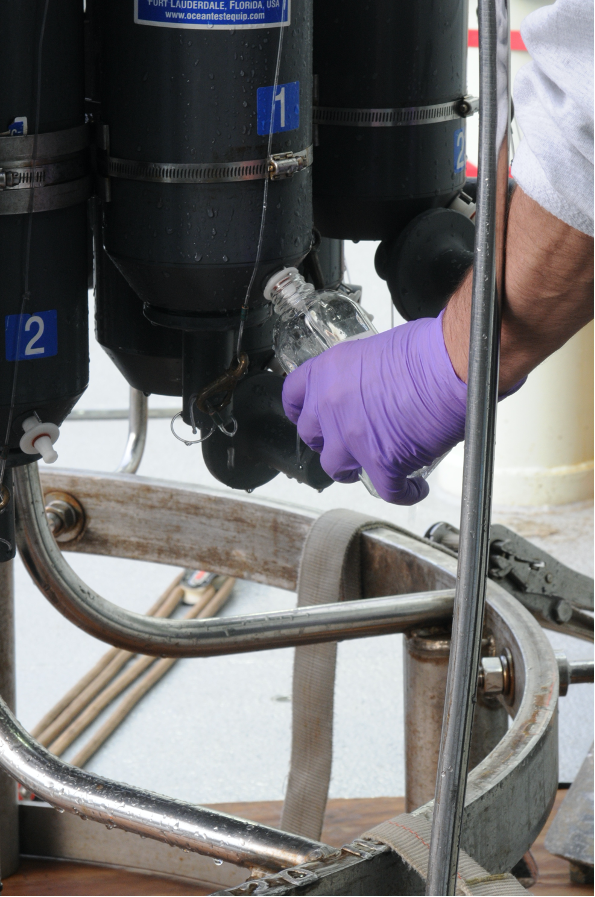 Collecting water samples from the CTD rosette on the Pioneer 8 cruise aboard the R/V Neil Armstrong. ©WHOI.[/caption]
Collecting water samples from the CTD rosette on the Pioneer 8 cruise aboard the R/V Neil Armstrong. ©WHOI.[/caption]
To make these data more easily accessible to the science community, we have developed a common template to provide a full set of discrete water sample data from a cruise. These “Discrete_Sample_Summary” spreadsheets include the details for each Niskin bottle fired on a CTD cast, the CTD instrument rosette data from the time of bottle closure, and the water sample data and quality flags based on World Ocean Circulation Experiment (WOCE) standards.
These CSV files with common data formats can easily be read and manipulated in MATLAB, Python, or other computing programs and languages. Because water analysis data are received at different times from different labs, these spreadsheets are updated as data become available. An accompanying README file contains version history, general notes, and a description of the quality flags. The original spreadsheets from labs, which may contain additional data and methodology, will also be posted.
An example of how to read and use this discrete sample data can be found in this Jupyter notebook. Discrete_Sample_Summary spreadsheets have been posted for the Regional Cabled Array cruises 6-10, the Coastal Endurance Array cruises 1-13, and the Global Irminger Sea Array cruises 1-6. We will continue to work on completing spreadsheets for past cruises as well as cruises going forward.
[caption id="attachment_20261" align="aligncenter" width="640"]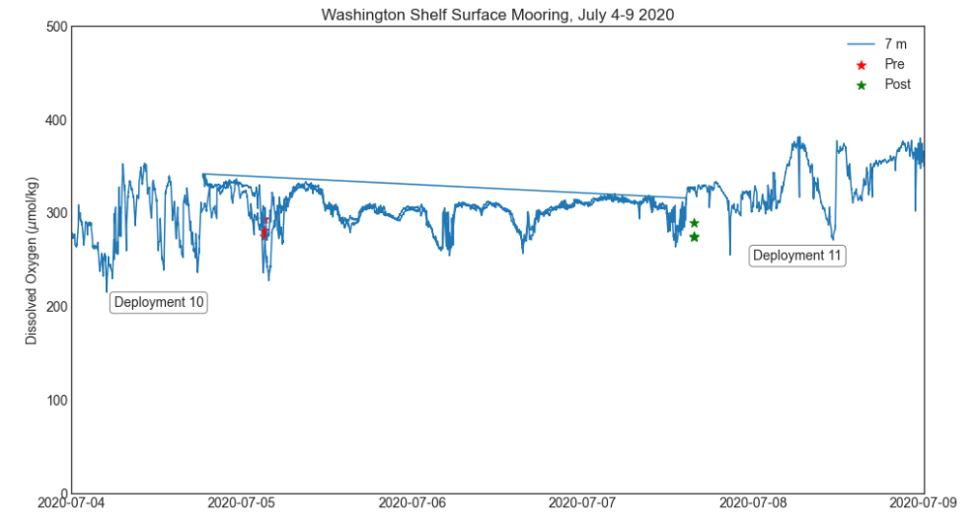 Comparison of dissolved oxygen data on the Washington Shelf Surface Mooring with water sampling data from Endurance Cruise 13. Data from Deployment 10 and Deployment 11 are plotted together, and overlap during 5-7 July.[/caption]
Read More
Comparison of dissolved oxygen data on the Washington Shelf Surface Mooring with water sampling data from Endurance Cruise 13. Data from Deployment 10 and Deployment 11 are plotted together, and overlap during 5-7 July.[/caption]
Read More Pioneer Data Complements Fisher-Collected Data to Explain Ocean Processes and Fish Distributions
Since 2014, fishers in southern Rhode Island and scientists from Woods Hole Oceanographic Institution (WHOI) have been working collaboratively to share data and learn from one another. For the past seven years, fishers have been collecting oceanographic data through the Commercial Fisheries Research Foundation’s (CFRF) Shelf Research Fleet and WHOI has shared data collected by the Pioneer Array.
Through this partnership, fishers have come to value data from the Shelf Research Fleet and the Pioneer Array, as well as the insights of researchers who have spent years studying some of the most productive fisheries in U.S. waters. WHOI provides Pioneer data to fishers, and fishers provide oceanographic data collected during their normal fishing operations using CTDs which measure conductivity, temperature and depth information through the CFRF/WHOI Shelf Research Fleet. When the CTDs are brought onboard they wirelessly communicate the temperature data to an iPad where fishermen can view oceanographic conditions and ultimately upload the data to scientists. These CTD measurements provide the physical properties of sea water, which help determine the location and composition of the catch.
[caption id="attachment_20251" align="alignright" width="300"]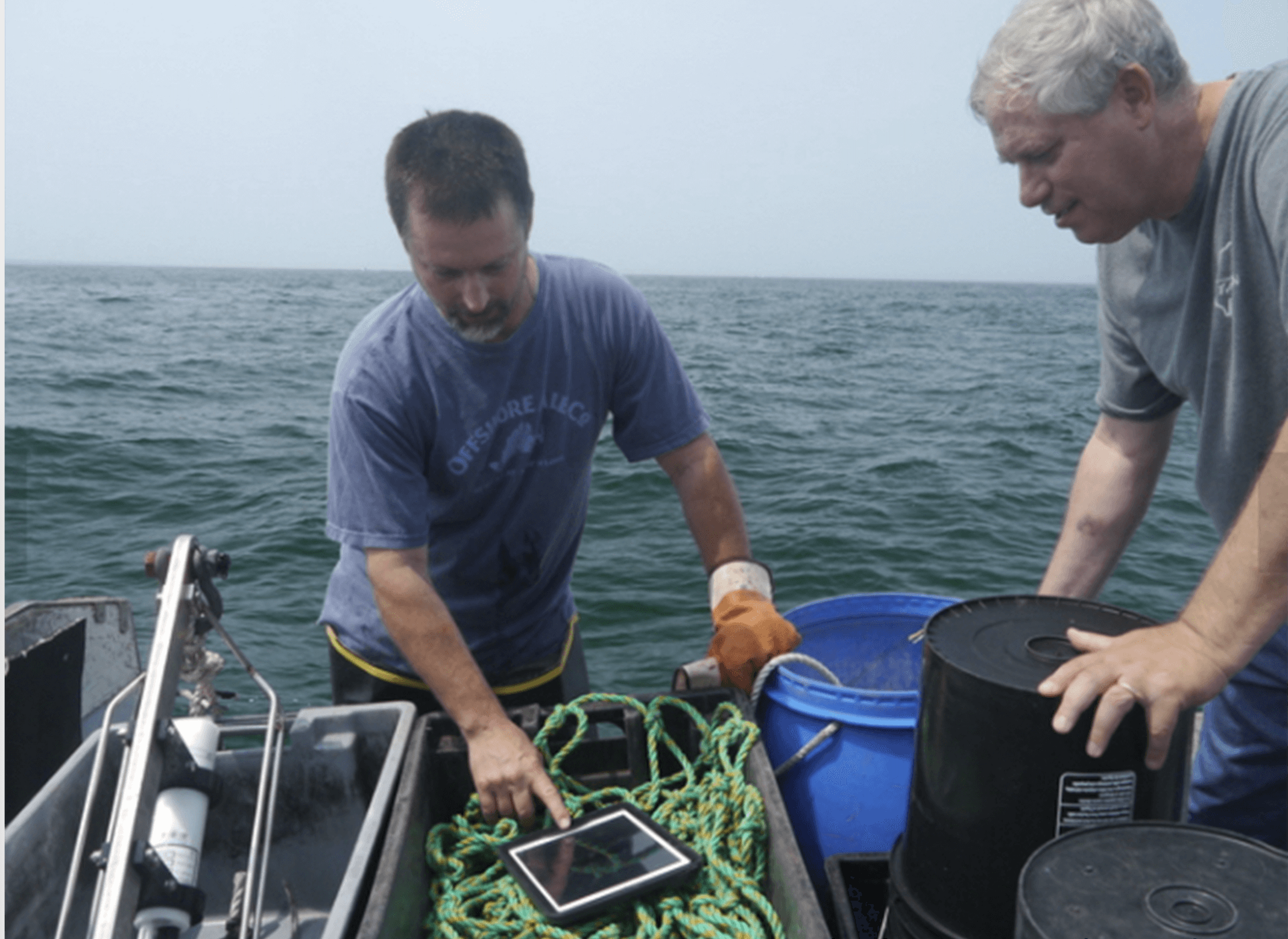 Fisher Michael Marchetti (left) and WHOI scientist Glen Gawarkiewicz discuss data collected by a portable CTD. Credit: Commercial Fisheries Research Foundation.[/caption]
Fisher Michael Marchetti (left) and WHOI scientist Glen Gawarkiewicz discuss data collected by a portable CTD. Credit: Commercial Fisheries Research Foundation.[/caption]
“This arrangement is a good example of how if people are willing to listen and really learn to value issues that are going on for another group, remarkable things can occur,” said Glen Gawarkiewicz, a WHOI researcher who leads the CFRF -WHOI Shelf Research Fleet.
In December, Gawarkiewicz visited the sea surface temperature website maintained by Rutgers University. There he noticed a sea surface temperature image that seemed to suggest a patch of warm, salty water known as a warm core ring forming directly adjacent to the continental shelf in the vicinity of the Pioneer Array. Warm core rings form when the Gulf Stream becomes unstable. These meanders can break off forming a swirling mass of water dozens of miles across, with warm water at the center that can be transported away from the Gulf Stream and into normally cold coastal waters of New England. Once there, such eddies can disrupt ecosystems and affect weather patterns for weeks.
[caption id="attachment_20250" align="alignleft" width="300"]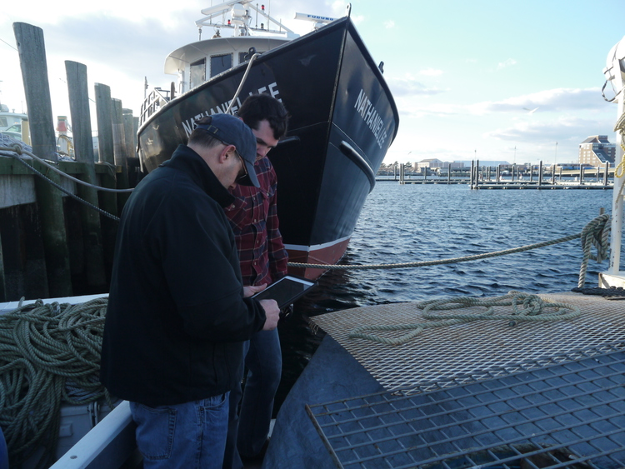 Newport Rhode Island lobsterman James Violet (foreground) reviews oceanographic data collected via CTDs on WHOI provided iPads. Credit: Commercial Fisheries Research Foundation.[/caption]
Newport Rhode Island lobsterman James Violet (foreground) reviews oceanographic data collected via CTDs on WHOI provided iPads. Credit: Commercial Fisheries Research Foundation.[/caption]
Gawarkiewicz then went to the Ocean Observatories Initiative data portal and made plots that confirmed the existence of high-salinity surface water near one of Pioneer’s offshore moorings and near the seafloor of one of the array’s inshore moorings. The conditions, he said, were very much like an event in January 2017 in which fish normally associated with warm Gulf Stream waters were caught near Block Island. The event in January 2017 was initially identified in Shelf Research Fleet data and then confirmed in Pioneer Array glider data analyzed by Robert Todd of WHOI.
Acting on the solid relationship built between WHOI and the CFRF, Gawarkiewicz emailed CFRF staff to warn them that conditions were changing and that they should be on alert for changes in the fishery. Shortly after, he received a phone call from Shelf Fleet collaborator, Aubrey Ellertson, who had reported that fishers were noticing an increase in water temperature on the bottom of the seafloor, and an impact on their catch. For some fishers, the Jonah crab fishing declined, and for others they were not seeing traditional fish species caught in their gillnets.
This exchange highlights the strong partnership between WHOI and the Rhode Island fishing fleet. The collaboration has helped participating fleet members recognize oceanographic processes and relate their fishing catch to processes discussed with WHOI scientists like Gawarkiewicz, and his colleagues Magdalena Andres, Ke Chen, and Massachusetts Institute of Technology/WHOI Joint Program graduate Jacob Forsyth. At the same time, Gawarkiewicz and his team have learned from the fishing community about the impacts of warm core rings on species distribution, their catch and, more broadly, on the shelf ecosystem.
“I knew to pass along this alert because members of the Shelf Research Fleet have taught me about what fishing outcomes are likely from some changing ocean conditions,” said Gawarkiewicz. “It is truly remarkable how much we have been able to learn from each other.”
Gawarkiewicz believes that this event demonstrates both the practical and intellectual value of the Pioneer Array data in improving understanding of sub-surface exchange processes. “Without Pioneer, we would not know the bottom salinity nor been able to give the fishers a heads-up as to what to expect. This shows how Pioneer is having a direct impact on how, when, and where people are fishing.”
To hear an audio piece with interviews with Gawarkiewicz, Aubrey Ellertson and others, listen here.
Read More

